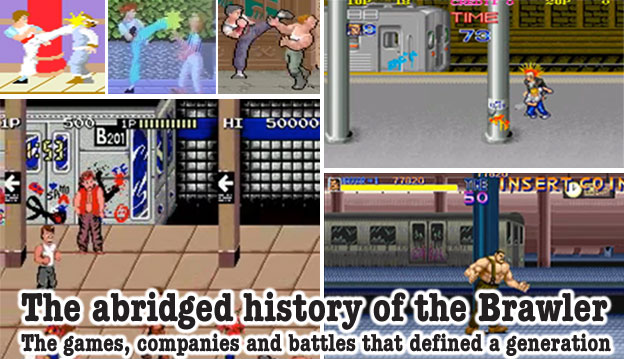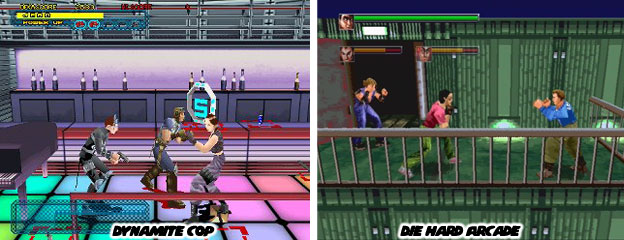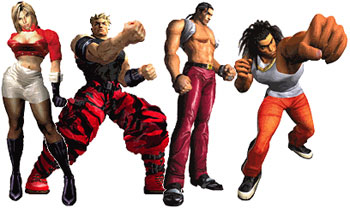
The game industry was quickly shifting. By 1998 polygon based titles were becoming more prevalent in arcades and even home consoles were becoming capable of processing decent 3D graphics, complete with textures and lighting effects. The era of the sprite was quickly coming to an end and the genres that depended on it would have to evolve or die. Sega started the shift with brawlers to 3D with Dynamite Cop / Die Hard Arcade. It borrowed the classic formula of having up to two characters take on scores of bad guys, in this case it was a male and female police officer against terrorists, tattooed goons, thugs and rogue cops. There were even outlandish boss battles against giant characters and even monstrous creatures.
Despite being built with 3D polygons instead of sprites the game actually kept the 2D gameplay. Characters could only face left or right. Fighting or shooting at opponents diagonally was out of the question. While this made little sense to gamers it worked in favor of the gameplay itself. The title also featured quick time events where a character would be seen running down a corridor, a prompt would have the player punch, kick or jump, if the player was successful then they would avoid a battle with opponents and move directly onto the next stage. For a first attempt at a 3D brawler Sega played it safe with the gameplay and gave audiences a fun title.

Sega followed up Dynamite Cop with a true 3D brawler that same year, SpikeOut: Digital Battle Online. Having more experience with polygon-based fighting engines than any other studio gave them a certain advantage.
In the title a gang of four people; Spike, White, Linda, Tenshin, collectively called Team Spike, were going through a city to reclaim it from a crime lord. Players fought every possible brawling type of character, from lowly thugs and tattooed henchmen to yakuza in fine suits and riot police in full armor.

Where it differed from every other brawler up to that point was that the environments were free roaming 3D. Players were not limited by the pseudo 3D layout in sprite based games. Nor were they limited to being only able to face left or right while fighting opponents. For the first time in any brawler they could explore the levels and face wave after wave of enemy in all 360 degrees. This both excited and terrified gamers. When the combat was limited to left and right then players could see which opponents were the biggest threat and set up attacks in advance. When players were surrounded they might be able to handle the few characters in front or the sides, but when opponents went from the back or a blind spot then the player was at a loss. This made the game and gameplay more difficult.
I first saw the title in an advertisement on the pages of Gamest magazine. In it Spike was dropping an elbow from a fire escape some two or three stories up onto an unseen opponent. My eyes widened and by heart started pounding at the thought of being able to do whatever I wanted in a fight on a completely open 3D world. As much fun as I had been having with the Final Fight series I was wondering what it would be like to perform impossible attacks onto opponents in 3D. I wanted to find out if the elbow drop from the top of a building was indeed possible in the game. Never before in my wildest dreams did I ever think that I would be able to do that in a videogame, let alone a multi-player brawler.

Thankfully there was an arcade in Irvine that had a special every Thursday night. For $20 players could play every game in the massive arcade as many times as they wanted from 7PM to midnight. My coworkers and brothers took advantage of this and beat scores of new and classic games over the months. The arcade had a four-player setup of SpikeOut, which was not what I had expected. Each player got a single cabinet that was connected via LAN to the other machines. Sega in Japan had designed this cabinet with the idea that players would be able to drop in and out of the brawling adventure at any point in the story, whether they were in the same arcade or in another arcade connected to the Sega network. It was a revolutionary concept for arcade games to be connected on a network and important for the survival of brawling games to always have someone to play with. My brothers and I each had our own screens and were free to roam about the levels fighting gang members until being pointed out to the direction of the boss character. The fighting was frenetic and difficult. It was completely different gameplay than what we were used to, not as easy or enjoyable as what we had expected.
The difficulty aside SpikeOut exposed several flaws with the format. I was the biggest supporter of the brawler, but even I found it very redundant Assuming there were the same numbers of opponents that players had to fight in both 2D and 3D games in 3D the battles seemed to take longer and made players feel less invincible that the classic brawling heroes. In 2D opponents could be stunned or dropped with a few hits and new opponents would step in to take their place. In SpikeOut, and future 3D brawlers, opponents could sidestep or even block strikes so players would have to keep trying different moves in order to knock them down. By that time they were often getting hit by the opponents closing in from the sides or behind. The worst thing was having the attacks miss an opponent because they were a few degrees off to the left or right. The game engine did not auto correct the trajectory for the player. Some of these things were resolved with SpikeOut: Final Edition released a year later but not having these concessions made before the game was released was a mistake. For my brothers and I playing and beating the game a couple of times was enough to satisfy my curiosity.
Actually I wasn’t satisfied with the game until I got a chance to drop an elbow onto an opponent from a few stories up. In one level, set inside a mall, my friends and brothers were battling a boss character. I told them to keep him busy while I climbed to the top of the stage. I went up about five or six virtual stories, jumped onto the railing and launched myself over with an elbow drop. I missed the boss but landed on his henchmen with a high speed thud. My brothers were laughing as I seemed to appear out of nowhere on their screen. My health bar did not suffer from the stunt so I kept running up and dropping elbows from the rafters. It was a glorious thing from an otherwise lackluster brawling experience. The shift to 3D had begun but some genres did not seem to make the transition smoothly. The following year would see two studios try to keep the traditional sprite-based brawler alive. I hope to see you return for that blog. As always if you enjoyed this blog and would like to sponsor me please visit my Patreon page and consider donating each month, even as little as $1 would help make better blogs and even podcasts!

Where it differed from every other brawler up to that point was that the environments were free roaming 3D. Players were not limited by the pseudo 3D layout in sprite based games. Nor were they limited to being only able to face left or right while fighting opponents. For the first time in any brawler they could explore the levels and face wave after wave of enemy in all 360 degrees. This both excited and terrified gamers. When the combat was limited to left and right then players could see which opponents were the biggest threat and set up attacks in advance. When players were surrounded they might be able to handle the few characters in front or the sides, but when opponents went from the back or a blind spot then the player was at a loss. This made the game and gameplay more difficult.
I first saw the title in an advertisement on the pages of Gamest magazine. In it Spike was dropping an elbow from a fire escape some two or three stories up onto an unseen opponent. My eyes widened and by heart started pounding at the thought of being able to do whatever I wanted in a fight on a completely open 3D world. As much fun as I had been having with the Final Fight series I was wondering what it would be like to perform impossible attacks onto opponents in 3D. I wanted to find out if the elbow drop from the top of a building was indeed possible in the game. Never before in my wildest dreams did I ever think that I would be able to do that in a videogame, let alone a multi-player brawler.

Thankfully there was an arcade in Irvine that had a special every Thursday night. For $20 players could play every game in the massive arcade as many times as they wanted from 7PM to midnight. My coworkers and brothers took advantage of this and beat scores of new and classic games over the months. The arcade had a four-player setup of SpikeOut, which was not what I had expected. Each player got a single cabinet that was connected via LAN to the other machines. Sega in Japan had designed this cabinet with the idea that players would be able to drop in and out of the brawling adventure at any point in the story, whether they were in the same arcade or in another arcade connected to the Sega network. It was a revolutionary concept for arcade games to be connected on a network and important for the survival of brawling games to always have someone to play with. My brothers and I each had our own screens and were free to roam about the levels fighting gang members until being pointed out to the direction of the boss character. The fighting was frenetic and difficult. It was completely different gameplay than what we were used to, not as easy or enjoyable as what we had expected.
The difficulty aside SpikeOut exposed several flaws with the format. I was the biggest supporter of the brawler, but even I found it very redundant Assuming there were the same numbers of opponents that players had to fight in both 2D and 3D games in 3D the battles seemed to take longer and made players feel less invincible that the classic brawling heroes. In 2D opponents could be stunned or dropped with a few hits and new opponents would step in to take their place. In SpikeOut, and future 3D brawlers, opponents could sidestep or even block strikes so players would have to keep trying different moves in order to knock them down. By that time they were often getting hit by the opponents closing in from the sides or behind. The worst thing was having the attacks miss an opponent because they were a few degrees off to the left or right. The game engine did not auto correct the trajectory for the player. Some of these things were resolved with SpikeOut: Final Edition released a year later but not having these concessions made before the game was released was a mistake. For my brothers and I playing and beating the game a couple of times was enough to satisfy my curiosity.
Actually I wasn’t satisfied with the game until I got a chance to drop an elbow onto an opponent from a few stories up. In one level, set inside a mall, my friends and brothers were battling a boss character. I told them to keep him busy while I climbed to the top of the stage. I went up about five or six virtual stories, jumped onto the railing and launched myself over with an elbow drop. I missed the boss but landed on his henchmen with a high speed thud. My brothers were laughing as I seemed to appear out of nowhere on their screen. My health bar did not suffer from the stunt so I kept running up and dropping elbows from the rafters. It was a glorious thing from an otherwise lackluster brawling experience. The shift to 3D had begun but some genres did not seem to make the transition smoothly. The following year would see two studios try to keep the traditional sprite-based brawler alive. I hope to see you return for that blog. As always if you enjoyed this blog and would like to sponsor me please visit my Patreon page and consider donating each month, even as little as $1 would help make better blogs and even podcasts!

No comments:
Post a Comment